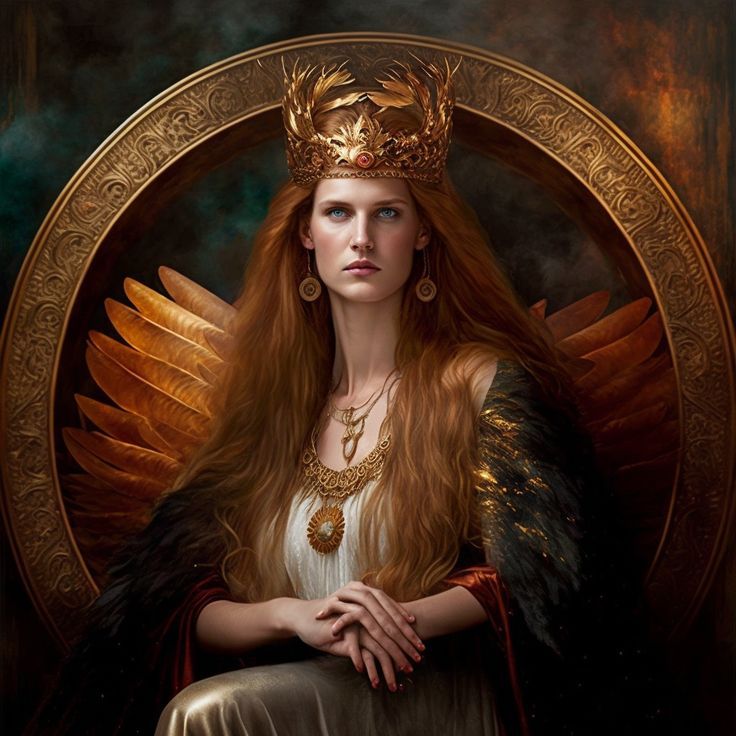Frigga is a goddess of Norse Mythology, the goddess Mother of the gods’ Aesir. She was the daughter of the earth goddess Fjorgyn and sister of the god Thor. Mother of the gods Baldur, Bragi, Hermod, Hodur and Idunna. It is known by the names: Frigg, Frige, Frija, Fricka, Frea, Frewa, Fruwa, Hlin, Hlyn, and Lin. Married to Odin, she is the lady of marriage, conjugal love, union, family, mothers, domestic activities, household management, and fertility.
Her name meant “A Beloved” and she was extremely wise. She was represented by a beautiful woman with silver hair braided with gold threads. He wore a blue robe with hawk and hawk feathers, with many jewels and precious stones. He also had a bunch of keys on his belt. Despite her telluric origin, she was the goddess of heaven and time. From his throne, which was in the clouds, he watched everything that happened in the nine worlds.
She lived in her Fensalir castle with twelve goddesses who helped her. These goddesses were: Eir, Fulla, Gefjon, Gna, Hlin, Lofn, Saga, Sjofn, Snotra, Syn, Var, and Vor. They were virgin goddesses, that is, self-sufficient, and represented different facets of Frigga. They were symbolizing various aspects of the female psyche. Fensalir was the place where the souls of the spouses who had been faithful to each other met after death, never to be separated. A star in the Orion Constellation is called “Friggajar Rockr” in his honor.
Even though she is known as a wife and mother, Frigga has several other essential functions. One of his attributes was to spin the threads of destiny with his gold spindle and deliver them to the Nornir – goddesses of fortune. She knew everything but said nothing. The great web of destiny woven by the Nornir followed the Sun’s trajectory and formed the so-called “fabric of life.” Frigga was also invoked in childbirth for the protection of babies and in all-female rites of passage.
She advised Odin using her precognition and wisdom and sometimes acted contrary to him (favoring her favorite heroes and giving them victory in battles). Frigga is the only one, besides Odin, who can sit on the Hlidskialf (throne where Odin and Frigga can see the nine worlds). Friday is the day dedicated to her (along with Freyja and Frey), so Friday in English is Friday, which means “Frigg’s Day” (the day of Frigg).
As an archetypal image, Frigga approaches the Greek goddess Hera and the Roman Juno as the goddess of marriage, partnerships, family life, lady of heaven, and conjugal fidelity. But while Hera and Juno were downgraded in status and portrayed as jealous and vindictive goddesses, Frigga did not compete with Odin’s mistresses, for in addition to possessing the gift of prophecy (so she knew before her husband’s escapades), for the Nordics, the concept marriage was quite different. Despite being polygamous, Nordic women were more respected than Greek and Roman women. Women could divorce and marry another and played a more active role, including as warriors.
Frigga is the great lady of destiny and magic, showing that destiny is feminine, cyclical, maternity, fertility, and conjugal unions, which shows that this goddess represents initiation and profound aspects of the feminine. Motherhood, care for the home and family, union with the opposite sex (as a sacred marriage), and the knowledge of destiny, which appears to women as sudden intuitions, are tools for transforming the woman’s personality.
One of its symbols was the spindle. The spindle is a powerful feminine symbol that represents wisdom, virtue, and mystery. For Von Franz (2010), the spindle and the act of spinning are female activities, with the implications of sexuality and fertility. The spindle is a symbol of witches and wise women. Spinning helps develop patience and decreases the feverish activity of the animus (male side of the woman). The woman learns that everything has cycles and time to develop. It takes patience, calm, and concentration to spin.
Fertility and sexuality appear in Frigga. When women wanted to get pregnant, they resorted to her. Despite being a symbol of loyalty, Frigga lived with Odin’s brothers, Vili and Vé, in his absence. She came to be accused of adultery by Loki but defended herself by stating that the brothers were aspects of Odin. Besides, in some ancient texts, Frigga bargained for his body for jewelry. They submitted to a dwarf to escape Odin’s punishment for stealing gold from a statue offered to him. We see here dark aspects of the feminine, such as extreme vanity and sexuality in exchange for favors (prostitution).
The goddess contains three aspects of the female trinity: the young woman, the mother, and the elderly woman. As well as the dark aspect of the feminine, thus forming a feminine quaternity. Thus, the goddess shows unique feminine completeness. Completeness of aspects of the feminine, with the elderly, the wife, the wise, the young, the virgin, and the seducer. And, mainly, the knowledge of the destination and the acceptance of it, which is cyclical.
